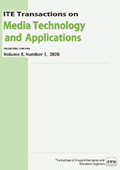8 巻, 1 号
選択された号の論文の8件中1~8を表示しています
- |<
- <
- 1
- >
- >|
Special Section on Advanced Multimedia Transmission Technology and Its Application
-
2020 年8 巻1 号 p. 1
発行日: 2020年
公開日: 2020/01/01
PDF形式でダウンロード (407K) -
2020 年8 巻1 号 p. 2-10
発行日: 2020年
公開日: 2020/01/01
PDF形式でダウンロード (653K) -
2020 年8 巻1 号 p. 11-17
発行日: 2020年
公開日: 2020/01/01
PDF形式でダウンロード (322K) -
2020 年8 巻1 号 p. 18-30
発行日: 2020年
公開日: 2020/01/01
PDF形式でダウンロード (1551K) -
2020 年8 巻1 号 p. 31-39
発行日: 2020年
公開日: 2020/01/01
PDF形式でダウンロード (4512K) -
2020 年8 巻1 号 p. 40-48
発行日: 2020年
公開日: 2020/01/01
PDF形式でダウンロード (1444K)
Regular Section
-
2020 年8 巻1 号 p. 49-59
発行日: 2020年
公開日: 2020/01/01
PDF形式でダウンロード (4458K) -
2020 年8 巻1 号 p. 60-68
発行日: 2020年
公開日: 2020/01/01
PDF形式でダウンロード (1304K)
- |<
- <
- 1
- >
- >|
